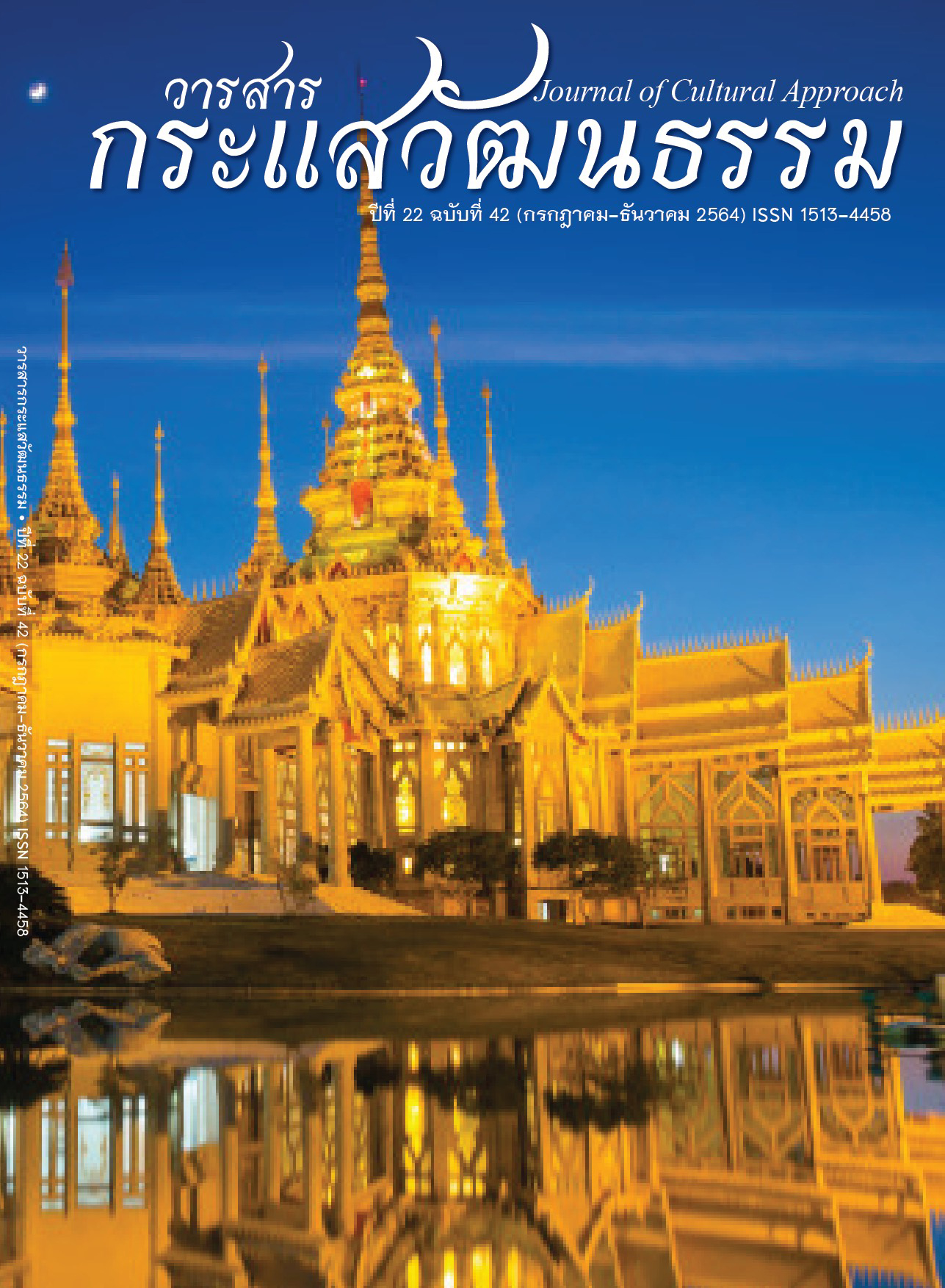Wisdom of Building a Clay House for Living in Maha Sarakham Province
Main Article Content
Abstract
This research aimed to 1) study the history of the wisdom of building a clay house for living, and 2) study the current conditions on the wisdom of building a clay house for living. The study was qualitative research and divided the sampling into 3 groups: (1) Key informants, (2) Stakeholders/Operators, and (3) Individuals, a total of 30 people. Data were collected from documents, preliminary fieldwork, structured and unstructured interviews, participation and non-participation observation, and focus group.
The study found that 1) history began when Chinese people were populated by trade and brought the style of building houses into Maha Sarakham City. The building is popularly created as a single-layer fixed floor. A clay-brick wall-generating will connect “Lao Teng” or the mezzanine to store products.
2) The clay house is still seen on Nakhon Sawan Road, Maha Sarakham province, but in the early days, the construction of residences and shops was made of clay bricks that mixed with rice husk, sand, and chopped straws. Then, it is packed into a wooden size 12” x 6” x 41” and taken to dry with sunbathing 2 – 3 times.
In conclusion, building a clay house in the present is to regain the traditional knowledge of the north-eastern antecedents and combine modern knowledge. The beginning of building clay houses is to create eco-friendly housing, reduce the destruction of nature, and help the homeless to have a durable and permanent home.
Article Details
Proposed Creative Commons Copyright Notices
1. Proposed Policy for Journals That Offer Open Access
Authors who publish with this journal agree to the following terms:
- Authors retain copyright and grant the journal right of first publication with the work simultaneously licensed under a Creative Commons Attribution License that allows others to share the work with an acknowledgement of the work's authorship and initial publication in this journal.
- Authors are able to enter into separate, additional contractual arrangements for the non-exclusive distribution of the journal's published version of the work (e.g., post it to an institutional repository or publish it in a book), with an acknowledgement of its initial publication in this journal.
- Authors are permitted and encouraged to post their work online (e.g., in institutional repositories or on their website) prior to and during the submission process, as it can lead to productive exchanges, as well as earlier and greater citation of published work (See The Effect of Open Access).
Proposed Policy for Journals That Offer Delayed Open Access
Authors who publish with this journal agree to the following terms:
- Authors retain copyright and grant the journal right of first publication, with the work [SPECIFY PERIOD OF TIME] after publication simultaneously licensed under a Creative Commons Attribution License that allows others to share the work with an acknowledgement of the work's authorship and initial publication in this journal.
- Authors are able to enter into separate, additional contractual arrangements for the non-exclusive distribution of the journal's published version of the work (e.g., post it to an institutional repository or publish it in a book), with an acknowledgement of its initial publication in this journal.
- Authors are permitted and encouraged to post their work online (e.g., in institutional repositories or on their website) prior to and during the submission process, as it can lead to productive exchanges, as well as earlier and greater citation of published work (See The Effect of Open Access).
References
Atiyanichchayapong, N. (2014). Livelihood of People in Rural Isan: Changes Over the Past Decade. Journal of Sociology and Anthropology, 33(2), 103-127.
Boonsilp, P. (2018). Clay House. Faculty of Education, Mahasarakham Rajabhat University.
Chantavanich, S. (2004). Data Analysis in Qualitative Research. Bangkok: Chulalongkorn University Press.
Kaewwanna, P. (n.d.). Theoretical Concepts on Local Wisdom. Retrieved from http://www.udtu.ac.th/oldsite/attachments/elearning/10/08.pdf
Mahasarakham Provincial Cultural Office. (2013). Location and Territory. Retrieved from http://www.m-culture.go.th/mahasarakham/ewt_news.php?nid=64
Nudtasara, T. et al. (2015). Life Living and Cultural Existence of Ethnic Groups in Pai, Mae Hong Son. Chiang Mai: Chiang Mai Rajabhat University.
Office of the National Economic and Social Development Council. (2017). National Economic and Social Development Plan No.12 (2017-2021). Retrieved from http://www.nesdc.go.th/ewt_dl_link.php?nid=6422
Parisuthiwuthiporn, N. (2003). Chinese and the Expansion of Cities on Chi River. Faculty of Humanities and Social Sciences, Mahasarakham University.
Sinlapasai, D. (2003). Earth House: An Alternative Architecture Case Study: Bann Srithan, Amphor Pateaw, Yasothon Province. Faculty of Architecture, Silpakorn University.
Sukna, S. (2018). Clay House Wisdom. Faculty of Fine Arts, Mahasarakham University.
Thananchaibutr, P. (2018). Where is the Beauty (in Photography)? Retrieved from http://imagetalk-kmitl.blogspot.com/2018/05/where-is-the-beauty-in-photography.html


